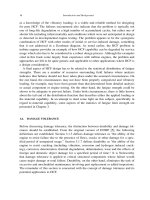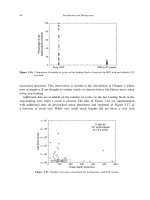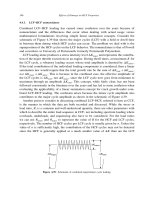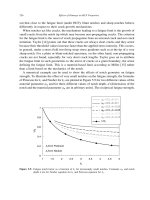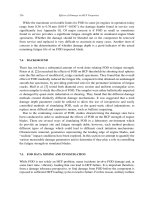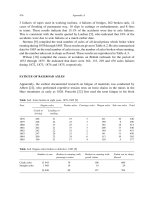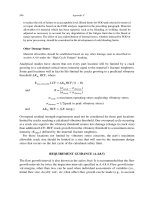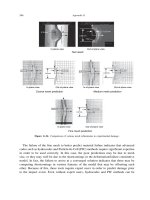Concise Dictionary of Materials Science Part 4 potx
Bạn đang xem bản rút gọn của tài liệu. Xem và tải ngay bản đầy đủ của tài liệu tại đây (61.95 KB, 5 trang )
dispersion strengthening
Strength increase caused by incoherent particles, in
comparison to the matrix phase. See Orowan mechanism.
dispersoid
See dispersed phase. This term frequently relates to inert, e.g., oxide,
particles in dispersion-strengthened alloys or to incoherent precipitates.
dispersoid-free zone
Narrow, particle-free zone delineating the grain bound
-
aries arranged perpendicular to the principal tensile stress in the sample.
Such zones occur because of diffusional creep.
displacement cascade
Cluster of various point defects, mostly vacancies and
self-interstitials, occurring due to irradiation damage by high-energy (∼1
MeV) ions or thermal neutrons. The size of the clusters depends on both
the mass and energy of the primary particles and on the atomic mass in
the material irradiated. Cascades are characterized by a high concentration
of self-interstitials at the cascade periphery and by an identical concen
-
tration of vacancies in the cascade core.
displacement shift complete (DSC) lattice
Auxiliary lattice used for descrip-
tion of the atomic structure of high-angle grain boundaries. Planes of
DSC lattice are parallel to the CSL planes and pass through all the atomic
sites in the crystal lattices of two disoriented grains. The shift of the CSL
along any translation vector of the DSC lattice changes only the CSL
position, and does not change the CSL itself. Thus, these vectors can be
considered to be the Burgers vectors of perfect grain-boundary disloca
-
tions. The minimum length of the vector equals b/Σ, where b is the Burgers
vector of primary dislocation, and Σ is a CSL parameter.
displacive transformation
Name of shear-type transformation used in ceramic
science.
divacancy
Complex of two vacancies in adjacent lattice sites. Divacancy has a
smaller free energy in comparison to two single vacancies far removed
from one another.
divorced eutectoid
Microconstituent that, in binary systems, is supposed to be
two-phase (see eutectoid colony), but, in fact, is single-phase. Such a
structure forms when crystallites of the occurring solid phases grow inde
-
pendently, and crystallites of one of these phases join up with proeutectoid
crystals of the same phase. Divorced eutectoid is also observed when the
volume fraction of a phase undergoing eutectoid reaction is low (<5
vol%).
divorced pearlite
Divorced eutectoid in steels.
dodecahedral plane
{110} plane in cubic structures.
domain structure
In ferromagnetic and ferrimagnetic materials, a structure
formed by magnetic domains; in ferroelectrics, it is formed by ferroelec
-
tric domains. Domain structure decreases the energy of magnetic (or
electric) poles at the free surface of a body, at the grain boundaries and
interfaces, at particles whose size is greater than the domain wall thick
-
ness, etc. The energy is known as magnetostatic or electrostatic energy,
respectively. In the absence of an external magnetic (electric) field, domain
structure eliminates the poles completely, and the magnetization (polar
-
ization) vectors of various domains are oriented in such a way that their
© 2003 by CRC Press LLC
dispersion strengthening
Strength increase caused by incoherent particles, in
comparison to the matrix phase. See Orowan mechanism.
dispersoid
See dispersed phase. This term frequently relates to inert, e.g., oxide,
particles in dispersion-strengthened alloys or to incoherent precipitates.
dispersoid-free zone
Narrow, particle-free zone delineating the grain bound
-
aries arranged perpendicular to the principal tensile stress in the sample.
Such zones occur because of diffusional creep.
displacement cascade
Cluster of various point defects, mostly vacancies and
self-interstitials, occurring due to irradiation damage by high-energy (∼1
MeV) ions or thermal neutrons. The size of the clusters depends on both
the mass and energy of the primary particles and on the atomic mass in
the material irradiated. Cascades are characterized by a high concentration
of self-interstitials at the cascade periphery and by an identical concen
-
tration of vacancies in the cascade core.
displacement shift complete (DSC) lattice
Auxiliary lattice used for descrip-
tion of the atomic structure of high-angle grain boundaries. Planes of
DSC lattice are parallel to the CSL planes and pass through all the atomic
sites in the crystal lattices of two disoriented grains. The shift of the CSL
along any translation vector of the DSC lattice changes only the CSL
position, and does not change the CSL itself. Thus, these vectors can be
considered to be the Burgers vectors of perfect grain-boundary disloca
-
tions. The minimum length of the vector equals b/Σ, where b is the Burgers
vector of primary dislocation, and Σ is a CSL parameter.
displacive transformation
Name of shear-type transformation used in ceramic
science.
divacancy
Complex of two vacancies in adjacent lattice sites. Divacancy has a
smaller free energy in comparison to two single vacancies far removed
from one another.
divorced eutectoid
Microconstituent that, in binary systems, is supposed to be
two-phase (see eutectoid colony), but, in fact, is single-phase. Such a
structure forms when crystallites of the occurring solid phases grow inde
-
pendently, and crystallites of one of these phases join up with proeutectoid
crystals of the same phase. Divorced eutectoid is also observed when the
volume fraction of a phase undergoing eutectoid reaction is low (<5
vol%).
divorced pearlite
Divorced eutectoid in steels.
dodecahedral plane
{110} plane in cubic structures.
domain structure
In ferromagnetic and ferrimagnetic materials, a structure
formed by magnetic domains; in ferroelectrics, it is formed by ferroelec
-
tric domains. Domain structure decreases the energy of magnetic (or
electric) poles at the free surface of a body, at the grain boundaries and
interfaces, at particles whose size is greater than the domain wall thick
-
ness, etc. The energy is known as magnetostatic or electrostatic energy,
respectively. In the absence of an external magnetic (electric) field, domain
structure eliminates the poles completely, and the magnetization (polar
-
ization) vectors of various domains are oriented in such a way that their
© 2003 by CRC Press LLC
E
ε-carbide
Transient phase of an approximate composition Fe
2.4
C with the hex
-
agonal crystal structure precipitating in steels from as-quenched marten-
site at a low-temperature tempering treatment.
ε-martensite
Martensite with HCP crystal structure occurring either at high
external pressures or in some plastically deformed austenitic steels. Its
occurrence may be connected with the existence of HCP allotropic mod
-
ification of iron, known as ε-Fe.
η-carbide
Transient phase of composition Fe
2
C with orthorhombic crystal struc
-
ture; it precipitates in steels from as-quenched martensite at a low-tem
-
perature tempering treatment (at 50–200°C).
earing
Phenomenon revealing itself in the appearance of undulations along the
rim of deep drawn caps and connected with planar anisotropy of the sheet
used and, thus, with its crystallographic texture. The propensity for earing
can be estimated from the magnitude of
∆
r-value.
easy glide
Stage of plastic deformation in single crystals wherein only one slip
system is active and the strain hardening rate is low due to a small increase
in dislocation density. In crystals with HCP structure, such a stage can
be observed up to relatively high strains. In crystals with cubic crystal
structure, this stage is either rapidly relieved by multiple slip or is not
observed at all.
easy magnetization direction
Lattice direction along which the magnetization
energy in ferromagnetic or ferrimagnetic single crystals is minimum. In
Fe, it is 〈001〉; in Ni, it is 〈111〉; and in Co, it is 〈0001〉. Magnetization
vectors in magnetic domains lie close to or coincide with the easy mag
-
netization direction.
edge dislocation
Dislocation whose Burgers vector is perpendicular to its line.
It can be considered the edge of an extra plane inserted in a crystal lattice.
If the extra plane is situated above the slip plane of the dislocation, the
dislocation is assumed positive; in the opposite case, it is assumed nega
-
tive. It should be noted that the dislocation sense is a conventional char-
acteristic.
elastic deformation
Deformation induced by some external force and disappear-
ing after its removal. Elastic deformation can also be associated with
© 2003 by CRC Press LLC
F
face-centered cubic (FCC) structure
One of the two most densely packed crys-
tal structures (see Figure F.1) with coordination number 12, atomic pack
-
ing factor 0.74, and the close-packed planes {111} and close-packed
directions 〈110〉. The radius of tetrahedral void equals 0.225R and that
of octahedral void is 0.415R, where R is the atomic radius. In a densely
packed structure, the atoms of each most densely packed layer lie in the
hollows of the lower layer. In the FCC structure, the atom centers of the
second layer are arranged in the B hollows of the first layer (see Fig
-
ure F.2). The atom centers of the third layer are arranged in the hollows
of the second layer and above the C hollows of the first layer. The atom
centers of the fourth layer are arranged in the hollows of the third layer
and above the A centers of the first layer. Thus, the stacking sequence of
the atom layers {111} in FCC structure can be described as
…ABCABCA….
face-centered lattice
Cubic or orthorhombic Bravais lattice wherein, along with
the points at the vertices of the corresponding unit cell, there are additional
points at the centers of all the cell faces.
F-center
Color center occurring due to electron trapping by a vacancy in a cation
sublattice.
FIGURE F.1
Unit cell of FCC lattice.
FIGURE F.2
Sequence of close-packed planes
{111} in FCC lattice. See text.
C
B
A
© 2003 by CRC Press LLC
G
γ-Fe
Allotropic form of iron having FCC crystal structure and existing between
910° and ∼1400°C at atmospheric pressure.
γ ′-phase
In Ni alloys, an intermediate phase of composition Ni
3
(Ti,Al). The
phase has the same FCC lattice as the matrix, γ solid solution, although
the Ti and Al atoms in the γ′-phase lattice occupy cube vertices only,
whereas in the γ solid solution, they occupy the lattice sites randomly. At
a certain alloy composition, the interface between the γ′- and γ-phases is
perfectly coherent, and the precipitates of γ′-phase are stable to coarsen
-
ing.
garnet ferrite
Ferrimagnetic oxide of stoichiometry R
3
Fe
5
O
12
, where R is a
trivalent rare-earth element or yttrium.
gas constant
R = 8.314 J⋅mol
–1
⋅K
–1
= 8.62⋅10
–5
eV⋅K
–1
.
general grain boundary
High-angle grain boundary whose disorientation sig
-
nificantly differs from that of special boundaries. In terms of CSL, dis-
orientations at general boundaries are assumed to be characterized by Σ
> 25. The atomic structure of general boundaries is distorted, but is not
amorphous; it is not systematically described so far. General boundary is
also known as random boundary.
geometric coalescence
Merging of two adjacent grains of almost the same ori-
entation. Since their disorientation is small, they are separated by a sub
-
boundary, and their coalescence can occur without a significant rotation
of their lattices, as in the case of subgrain coalescence. See also grain
coalescence.
geometrically necessary dislocations
Dislocations contributing to the lattice
curvature inside a grain (subgrain) or to disorientation of a low-angle
boundary. For instance, consider a grain in which there are only parallel
edge dislocations of different sense. If the numbers of dislocations of the
opposite sense, N
+
and N
–
are the same, geometrically necessary disloca-
tions in the grain are lacking. If, however N
+
> N
–
the number of geomet-
rically necessary dislocations equals N
+
– N
–
.
Gibbs’ free energy
Free energy
G = H – TS
© 2003 by CRC Press LLC


